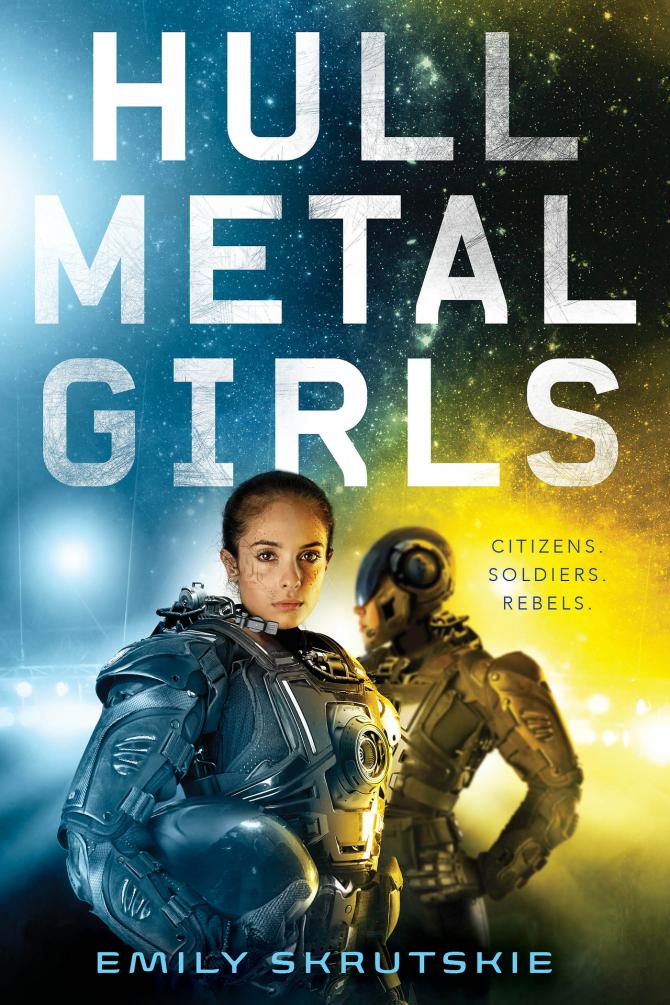
Hullmetal Girls by Emily Skrutskie
Words By Carolyn Janecek
After spending three-hundred years scouring the universe for a habitable planet, humanity begins to fracture. Revolutionary factions develop, religions form around humanity’s exile from Earth, and circumstances force the protagonists to sell their bodies to the government and become Scela: mechanical soldiers that are neither fully human nor artificial intelligence. In Hullmetal Girls, Emily Skrutskie speculates about what an integrative relationship between humans and AI might look like, never losing sight of her characters’ humanity as they learn to accept themselves in their fight for justice.
The two narrators “take the metal” for very different reasons. Aisha hopes her Scela salary will be enough to keep her sister out of the sweatshop and to give her younger brother the medical care he needs to survive the wasting fever. Key wakes up from the surgery without any memory of why she would surrender her privileged life to become a soldier who’s hardwired to obey orders. In creating these backgrounds for her characters, Skrutskie avoids the tendency within science fiction to imagine futuristic societies that are “post-racial” or to simply replace our current social divides with new ones. Instead, Hullmetal Girls imagines how wealth, religion, and privilege will continue to function in the future. The class differences between Aisha and Key remain a point of conflict throughout their training, showing how deeply social structures are ingrained in their interactions.
Skrutskie further subverts science fiction tropes in her presentation of an artificial intelligence whose character goes beyond blatantly “evil” or fundamentally limited in its understanding of humans. Becoming Scela doesn’t just mean cutting up a body and rearranging it around robotic enhancements––an exo rig is installed directly into the patients’ neural network through their spine, creating a direct link between their consciousness and an AI. The exo’s AI is adaptable and links with each character in a way that is unique to them, reflective of how computer scientists train data and the way programs adapt to new information. Each Scela’s exo becomes a supporting character in itself. Aisha and her exo frequently clash over her religion as well as over what it means to have strength; Key’s exo acts as a protector, intimately aware of the fear surrounding her memory loss. Both exos were programmed with the same AI, and yet the two machines have very different ideas of what it means to protect their hosts or spur them on.
Throughout the novel, the characters and their exos reason, bargain, and integrate into a new mode of existence together. Their relationships are sometimes difficult to grasp, but even this confusion rings true to the Marshall’s advice to her new recruits: they will have to learn how to take care of each other, because no human will ever be able to relate to how they exist in the world. In Skrutskie’s universe, characters’ relationships with artificial intelligence are nuanced and integrative, instead of divided between the human and the non-human.
The strongest appeal of Hullmetal Girls, however,lies within Skrutskie’s focus on the emotional development of the girls who become Scela––she avoids the pitfall of science fiction novels that focus too much on their world’s technology, while failing to flesh out their characters. When the new Scela take the metal, Skrutskie thoroughly explores how they handle their newfound power. Aisha, who spent her whole life powerless within a stratified class system, finds a way to express her pent-up rage within a Scela body for the first time. She shows us that anger is a luxury, a tool, and a danger all at once.
Unfortunately, it isn’t until the end of the novel that Key’s character gets the background and development she deserves. Key spends a fair amount of the novel stuck in the anger and confusion surrounding her memory loss and struggles to move forward until she can recover pieces of her past. However, Key needs that time to emotionally center herself enough to begin exploring who she is, rather than who she was. Her final moments of resolve and personal growth do not disappoint; her story ends on a hopeful note of one’s ability to build oneself back up “around the holes.”
As the protagonists struggle to navigate their new bodies and minds, revolution is disrupting the General Body’s control over its subjects. The new Scela are torn between helping the families they’ve left behind and their exos’ wills, programmed to obey the government that made them. These moments remind the reader that the flip of a switch threatens to extinguish the glimmer of consciousness within the exo if it’s forced to turn on its host, creating a tension that persists to the novel’s climax. In the end, it’s not a rogue AI threatening to take over the protagonists’ free will, but the humans who created them.
While the overarching conflictof finding a planet where humanity can be truly free again is strikingly similar to so many other science fiction novels, it’s the characters that make Hullmetal Girls a refreshing narrative as Aisha and Key witness injustice, struggle for agency, and decide for themselves what it means to have humanity.